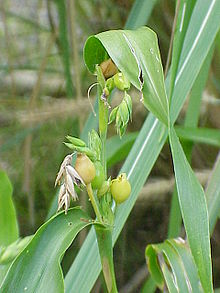Coix lachryma-jobi
| Job's tears | |
|---|---|
 |
|
| Scientific classification | |
| Kingdom: | Plantae |
| (unranked): | Angiosperms |
| (unranked): | Monocots |
| (unranked): | Commelinids |
| Order: | Poales |
| Family: | Poaceae |
| Subfamily: | Panicoideae |
| Tribe: | Andropogoneae |
| Genus: | Coix |
| Species: | C. lacryma-jobi |
| Binomial name | |
|
Coix lacryma-jobi L. |
|
| Synonyms | |
|
|
Job's tears (US) or Job's-tears (UK), scientific name Coix lacryma-jobi, also known as adlay or adlay millet, is a tall grain-bearing perennial tropical plant of the family Poaceae (grass family). It is native to Southeast Asia but elsewhere is cultivated in gardens as an annual. It has been naturalized in the southern United States and the New World tropics. In its native environment it is grown in higher areas where rice and corn do not grow well. Other common names include coixseed and tear grass. Job's tears are also commonly sold as Chinese pearl barley in Asian supermarkets, although C. lacryma-jobi is not closely related to barley (Hordeum vulgare).
There are two main varieties of the species, one wild and one cultivated. The wild variety, Coix lacryma-jobi var. lacryma-jobi, has hard-shelled pseudocarps—very hard, pearly white, oval structures used as beads for making rosaries, necklaces, and other objects. The cultivated variety Coix lacryma-jobi var. ma-yuen is harvested as a cereal crop, has a soft shell, and is used medicinally in parts of Asia.
The species was named by Carl Linnaeus in 1753 with the epithet as a Latin translation of the metaphorical tear of Job. As of February 2015[update], four varieties are accepted by the World Checklist of Selected Plant Families:
Besides the use for ornamental purposes, Job's tears grains are useful as a source of food (cereals) and folk medicine.
Throughout East Asia, Job's tears are available in dried form and cooked as a grain. The grains are generally spherical, with a groove on one end, and polished white in color, though in Japan unpolished yuuki hatomugi, which is unpolished and brown in color, is also available.
...
Wikipedia
